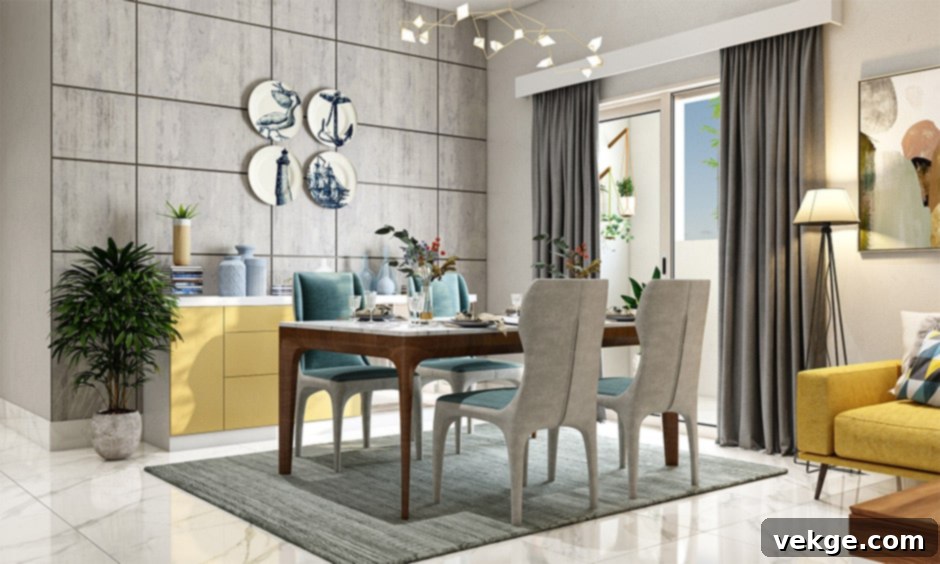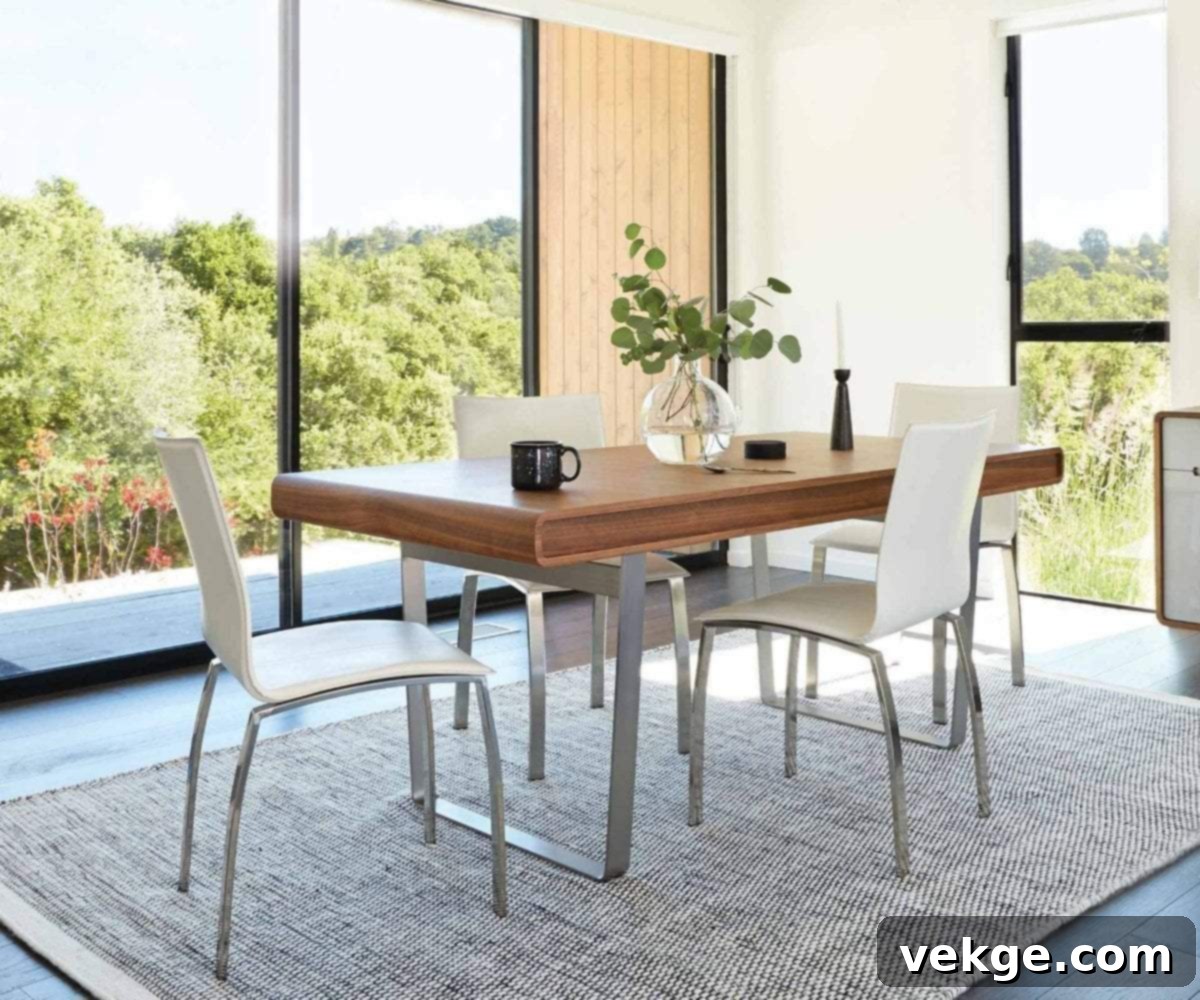Mastering the Art of Scandinavian Dining Rooms: Your Ultimate Guide to Minimalist Elegance and Functional Design
In the realm of interior design, few styles evoke such a profound sense of calm, functionality, and timeless beauty as Scandinavian design. Originating from the Nordic countries of Denmark, Norway, Sweden, Finland, and Iceland, this aesthetic is renowned for its emphasis on simplicity, clean lines, natural materials, and an innate connection to the natural world. It’s a design philosophy that champions quality over quantity, comfort over clutter, and light over darkness—a perfect antidote to the stresses of modern life.
If you’re looking to infuse your home with an atmosphere of sophisticated serenity and practical beauty, transforming your dining room into a Scandinavian sanctuary is an excellent place to start. A Scandinavian dining room is more than just a place to eat; it’s a space designed for gathering, for moments of “hygge” (coziness and well-being), and for appreciating the unpretentious beauty of well-crafted objects. However, many find themselves at a loss when it comes to translating these core principles into a cohesive and inviting dining space.
Fear not, aspiring Nordic design enthusiasts! This comprehensive guide will walk you through the essential elements and practical tips to create a dining room that is not only aesthetically pleasing but also perfectly embodies the functional elegance of Scandinavian style. Whether your preference leans towards stark minimalism, a warm nature-inspired touch, or a harmonious blend of both, every question you have about achieving that coveted Scandinavian dining room aesthetic is covered right here.
Essential Tips to Achieve the Aesthetical Scandinavian Dining Rooms

By thoughtfully implementing each of these guidelines, you can effortlessly transform your dining area into a space that exudes warmth, comfort, and undeniable Scandinavian charm.
1. Embrace a Dedicated Minimalist Design Approach
At the heart of Scandinavian design lies the principle of minimalism: “less is more.” This isn’t about stark emptiness, but rather about intentionality—curating a space where every item serves a purpose and contributes to the overall sense of calm and order. For your Scandinavian dining room, this translates into furniture choices that are purposeful, modest, and free from excessive ornamentation.
Opt for dining tables and chairs with clean, understated lines. Materials like light-toned woods (birch, ash, pine, or beech) are quintessential, chosen for their natural beauty and durability. A Scandinavian dining table typically features a simple, rectangular or round top with slender, often tapered legs, providing an uncluttered and expansive feel. Similarly, chairs should be unfussy, prioritizing comfort and ergonomic design without sacrificing aesthetic appeal. Their beauty comes from their understated elegance and craftsmanship rather than elaborate details. Remember, the fundamental rule here is to maintain a simple, uncomplicated aesthetic; fewer designs often create a greater impact, allowing the quality of materials and the spaciousness of the room to truly shine.
2. Harnessing the Power of Correct Lighting
Given the long, dark winters in Nordic countries, light plays an exceptionally crucial role in Scandinavian interiors. Maximizing natural light is always the first step: keep windows unobstructed and use light, sheer curtains or blinds that can be easily drawn back. For artificial lighting, the approach is layered and strategic, aiming to create a warm, inviting glow that combats darkness and enhances the room’s cozy ambiance.
The dining area’s focal point is often illuminated by a striking yet simple pendant light. Consider hanging a trendy pendant light made from natural materials such as wood, paper, woven fibers, or matte metal directly above your dining table. These fixtures not only provide essential task lighting but also serve as a sculptural element, defining the dining zone and adding character. Beyond the main pendant, integrate ambient lighting through floor lamps or wall sconces to soften shadows and create a diffused glow. Warm-toned bulbs are paramount, as they contribute significantly to the inviting and cozy atmosphere. The right lighting choices are not merely practical; they significantly enhance the aesthetic appeal and overall mood of your Scandinavian dining room.
3. Embracing the Natural Touch: Colors and Materials
Bringing the outside in is a hallmark of Scandinavian design, and this is beautifully achieved through the careful selection of color palettes and natural materials. The foundation of a Scandinavian dining room is typically built upon a neutral color scheme. Dominant shades of white, off-white, and various tones of grey are favored for walls and larger furniture pieces. These colors are chosen not only for their ability to reflect light, making spaces feel larger and brighter, but also for creating a serene and calming backdrop.
To prevent the space from feeling too stark, subtle pops of color are introduced, often inspired by nature. Think muted greens, dusty blues, soft pinks, or earthy terracotta tones. These can be incorporated through textiles like linen placemats, decorative cushions on dining chairs, ceramic tableware, or carefully chosen artwork. Natural materials are equally vital: light-colored wood is ubiquitous, but elements like wool, cotton, linen, leather, stone, and even glass further enhance the organic feel. Incorporate greenery with house plants, which not only add a vibrant splash of color but also improve air quality and connect the space to nature. If you’re interested in giving an aesthetic touch with personalized decor, consider minimalist wall art featuring abstract designs, landscapes, or botanical prints that resonate with the serene Nordic vibe.
4. Selecting the Perfect Dining Room Chairs
Dining chairs in a Scandinavian setting are not just functional pieces of furniture; they are often iconic design statements themselves, revered for their comfort, craftsmanship, and timeless appeal. When furnishing your dining area in a Scandi style, exploring various chair designs can inject visual interest and a subtle sense of eclecticism. While many opt for a matching set for cohesive harmony, mixing and matching dining chairs is a fantastic way to create a more personalized and dynamic look, provided there’s a unifying element such as a common material, color palette, or similar design silhouette.
Look for chairs crafted from light woods, sometimes with upholstered seats in natural fabrics like wool or linen for added comfort. Iconic Scandinavian chair designs like the Wishbone Chair, the Series 7 chair, or more modern interpretations with clean, minimalist lines are excellent choices. Ensure that despite their aesthetic appeal, the chairs are comfortable and ergonomically sound, inviting guests to linger and enjoy meals. The thoughtful selection of dining chairs truly embraces and completes the overall Scandinavian look, making guests feel welcomed and comfortable in the space.
5. Thoughtful Decorating and Styling Elements
The Scandinavian aesthetic extends to every detail, especially in decoration. However, this isn’t about accumulating trinkets; it’s about curating a few well-chosen items that enhance the space without creating clutter. The mantra “less is more” is paramount here. If you’re a nature lover, incorporating nature-inspired decor is a perfect fit. This could include a simple vase holding a single branch, a ceramic bowl filled with seasonal fruits, or minimalist wall art depicting natural landscapes or abstract forms.
Nordic interiors often favor a sophisticated palette, with black and white prints or framed abstract art frequently gracing the walls, providing stark contrast against light backgrounds. You can explore online prints that align with your personal taste while maintaining the minimalist ethos. Textiles play a crucial role in adding warmth and texture; think soft linen table runners, simple placemats, and perhaps a cozy sheepskin throw draped over a dining chair. Candles are indispensable for creating “hygge,” offering a warm, flickering light that instantly makes a room feel more intimate and inviting. Functional decor, such as beautifully designed serving dishes or a unique water carafe, further enhances the Scandinavian dining experience. Remember, each decorative item should contribute to the room’s sense of calm and thoughtful design.
Conclusion: Crafting Your Harmonious Scandinavian Dining Room
From the insights shared above, you now have a comprehensive understanding of how to achieve the minimalist yet deeply inviting aesthetic of Scandinavian dining rooms. The journey involves more than just selecting furniture; it’s about embracing a philosophy that prioritizes functionality, simplicity, natural elements, and the thoughtful use of light. By focusing on clean lines, light-enhancing colors, tactile natural materials, and carefully curated decor, you can transform your dining area into a tranquil and harmonious space.
Scandinavian designs inherently support an aesthetic touch with minimal fuss, creating environments that feel both elegant and utterly livable. However, the true essence of great design lies in personalization. While adhering to the core principles, don’t forget to infuse your own unique personality and preferences into the space. A treasured family heirloom, a piece of art that speaks to you, or a collection of handmade ceramics can add that crucial personal touch, making the space uniquely yours while still resonating with the Nordic aesthetic.
So, which of these tips resonated with you the most for creating your ideal Scandinavian interior? We’d love to hear your ideas on how you plan to style or have already styled your dining area. Share your thoughts and experiences in the comments below!
Frequently Asked Questions About Scandinavian Dining Rooms
What Is the Concept of Scandinavian Minimalism?
Scandinavian minimalism is a design philosophy deeply rooted in the Nordic countries, characterized by simplicity, functionality, and a connection to nature. It’s about stripping away the superfluous to reveal the essential, focusing on clean lines, uncluttered spaces, and purposeful design. This concept extends beyond aesthetics, influencing quality and durability in products and architecture. In a Scandinavian dining area, minimalism provides aesthetic vibes by creating a calm, open, and inviting environment free from distractions, emphasizing light, natural materials, and the beauty of understated forms.
Why Are Scandinavian Interiors Always Minimal?
Scandinavian interiors embrace minimalism for several compelling reasons, primarily influenced by the region’s climate and cultural values. The long, dark winters in Nordic countries necessitated designs that maximize light, often achieved through light color palettes and open, uncluttered spaces. Furthermore, the core values of “hygge” (coziness and contentment) and “lagom” (just the right amount) promote a lifestyle free from excess, focusing on comfort, well-being, and practicality. By reducing clutter and focusing on high-quality, functional pieces, Scandinavian design creates serene environments that are easy to maintain and conducive to a peaceful, balanced life.
What Are the Basic Features of Scandinavian Designs?
The basic features of Scandinavian design revolve around a few key principles: light and airy spaces, clean lines, and an emphasis on functionality without sacrificing beauty. Key characteristics include a dominant use of neutral color palettes (whites, greys, beige) to maximize natural light; extensive use of natural materials such as light-toned woods, wool, cotton, and leather; minimalist furniture with simple, elegant forms; and a focus on practical, durable items. Little to no ornamentation is preferred, with any decorative elements being thoughtful and purposeful. This style gained significant popularity in the 1950s, resonating with a desire for modern, accessible, and high-quality design.
What Are the Different Colours Used in Scandinavian Designs?
While Scandinavian design is often associated with a predominantly neutral palette, a range of colors is used to create warmth and depth. The primary colors are typically shades of white, off-white, and various light greys, which serve as the foundation for walls and large furniture items, reflecting light and creating an expansive feel. However, accent colors are skillfully incorporated to add personality and a natural touch. Popular choices include muted or dusty pastels like forest green, olive green, dusty pink, pastel blue, and soft terracotta or burnt orange. These colors are usually introduced through textiles, ceramics, artwork, or the occasional upholstered piece, providing subtle pops that complement the overall serene and natural aesthetic.
